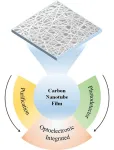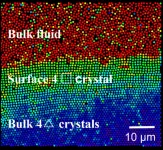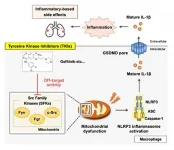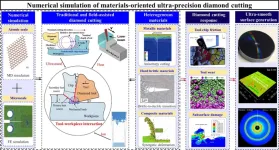(Press-News.org) A study with people who inject drugs evaluated a minimally invasive test based on dried blood spots (DBS) for the monitoring of hepatitis C virus (HCV) infection. The use of DBS samples for HCV RNA detection and genotyping was shown to effectively assess cure after treatment and to differentiate between reinfection and treatment failure. The results support the viability of decentralizing treatment and post-treatment monitoring for people who inject drugs, who frequently face challenges accessing the healthcare system. The study, which has been published in the Journal of Medical Virology, was carried out as part of a project with support from the "Conquering Hepatitis Via Microelimination" (CHIME) programme and a PFIS grant. Investigators from various research institutions collaborated in the project, including the Clinical Virology and New Diagnostic Tools research group, led by Dr Elisa Martró, at Germans Trias i Pujol Research Institute (IGTP) and Dr Sabela Lens from Hospital Clínic's Viral Hepatitis Group.
Towards elimination of hepatitis
In line with the strategy proposed by the World Health Organization for the elimination of viral hepatitis as a public health threat by 2030, and the Plan for Prevention and Control of Hepatitis in Catalonia, which Dr Martró actively participates in, her group has been focused for years on simplifying the diagnosis of hepatitis C by developing and validating an assay which can detect the virus RNA using DBS samples. These minimally invasive samples can be collected at harm reduction centres or drug dependence care and follow-up centres (known as CAS in Catalan), improving access to hepatitis C diagnosis for vulnerable populations, such as people who inject drugs. While this new test has demonstrated good clinical performance as a diagnostic tool for detecting HCV RNA before treatment in previous studies by the Clinical Virology and New Diagnostic Tools research group, the use of DBS samples had not been evaluated as a test for cure or for detecting reinfection after treatment.
A multidisciplinary research group has been able to pursue a project with a new model of care for hepatitis C, based on point-of-care diagnosis, treatment, and reinfection follow-up at the REDAN La Mina harm reduction centre. Since 2019, approximately 750 individuals who inject drugs have been tested though this initiative, which was designed by Dr Sabela Lens from Hospital Clínic's Viral Hepatitis Unit, in collaboration with the Clinical Virology and New Diagnostic Tools Research Group at Germans Trias i Pujol Research Institute (IGTP), led by Dr Martró from the Microbiology Service (LCMN) of the Germans Trias i Pujol Hospital (HUGTiP), as well as CEEISCAT and the Public Health Agency of Catalonia. The project had the support of the "Conquering Hepatitis Via Microelimination" (CHIME) programme from Gilead Sciences awarded to Dr Lens, as well as a PFIS grant of the Instituto de Salud Carlos III and the Fondo Social Europeo awarded to Anna Not, who is a member of Dr Martró's group, and aligns with the World Health Organization's global health strategy, which aims to eliminate hepatitis C as a public health problem by 2030.
A model of decentralised care
In this project, Dr Martró's group aimed to evaluate the clinical performance of a previously developed HCV-RNA assay based on DBS, for the assessment of cure and the detection of recurrent viremia after on-site treatment at the harm reduction centre, compared to the commercially available HCV-RNA point-of-care test. Furthermore, they sought to assess the possibility of distinguishing between reinfection and treatment failure through HCV genotyping from baseline and follow-up DBS samples. Typically, these assessments (cure and reinfection) are performed using venipuncture blood samples collected at healthcare centres, which can be difficult for people who inject drugs and have often limited access to the healthcare system. The recently published results demonstrate how the collection of DBS samples before and after treatment can simplify these assessments in decentralized test-and-treat programmes.
"The success of the CHIME project lies in the decentralized diagnosis and treatment provided at REDAN La Mina. A nurse trained in hepatology assessments was included in the study to enrol and visit participants. The hepatologists at Hospital Clínic also reviewed each case and prescribed decentralized treatment. Additionally, Dr Martró's group carried out HCV detection and sequencing from DBS samples collected before and after treatment. This pilot programme involves HCV diagnosis on-site in less than an hour, treatment at the same centre, and follow-up to assess reinfection", states Dr Lens.
Detection made easier
Reinfection is common in people who inject drugs and must be treated to prevent further transmission of the virus. During early reinfection, low levels of the virus may be present, making its detection in DBS samples challenging, as they only contain a small amount of blood. Of the 193 DBS samples tested after treatment, the DBS-based assay showed 100% specificity and sensitivity ranging from 84% to 96% based on different relevant viral load cut-offs, and similar rates as a test of cure (three months after treatment). It must be born in mind that among the patients with recurrent viremia after treatment, one tenth had low viral loads. Moreover, HCV genotyping allowed researchers to classify 73% of viremic cases as either reinfection or treatment failure.
Collection of DBS samples was done before antiviral treatment and after treatment if recurrent viremia was detected by the commercially available point-of-care assay. Anna Not, the first author of the article (which will be part of her PhD), explains that it "the use of DBS allowed us to sequence the virus before and after treatment and compare the sequences to determine if the virus was the same (indicating a treatment failure) or if it was different (indicating reinfection). This information enabled the hepatologist to decide on the most appropriate antiviral combination for the second treatment".
The research shows the potential of using DBS samples for determining cure and differentiating between reinfection and relapse after antiviral treatment for hepatitis C in people who inject drugs. The use of DBS samples makes it possible to decentralize treatment and follow-up, improving access to care for these people. Even so, Dr Martró points out that "a small number of patients had low viral loads, which can hinder the detection of viremia and genotyping in DBS. As a result, repeat testing (e.g. every six months) is advised for individuals who are at risk of HCV reinfection".
This study has been possible through the multidisciplinary collaboration between hepatologists from Group CB06/04/0004 of the CIBER in Hepatic Diseases (CIBEREHD) and experts in diagnostics and epidemiology from Group CB06/02/0057 of the CIBER in Epidemiology and Public Health (CIBERESP), including CEEISCAT (Centre d'Estudis Epidemiològics sobre les ITS i la Sida de Catalunya), with the support of REDAN La Mina (Parc de Salut Mar), and the Public Health Agency of Catalonia.
Reference
Not A, Saludes V, Gálvez M, Miralpeix A, Bordoy AE, González N, González-Gómez S, Muntané L, Reyes-Urueña J, Majó X, Colom J, Forns X, Lens S, Martró E. Usefulness of dried blood spot samples for monitoring hepatitis C treatment outcome and reinfection among people who inject drugs in a test-and-treat program. J Med Virol. 2023 Feb;95(2):e285
END
Breaking barriers in hepatitis C diagnosis and treatment for populations at risk
2023-03-17
ELSE PRESS RELEASES FROM THIS DATE:
UMass Amherst providing 30 three-year scholarships to boost diversity in mathematics and statistics
2023-03-17
AMHERST, Mass. – University of Massachusetts Amherst’s Department of Mathematics and Statistics is offering 30 three-year scholarships to a diverse cohort of students majoring in mathematics and statistics, thanks to a $1.5 million dollar grant from the National Science Foundation (NSF).
The six-year project, called Enhancing Underrepresented Participation in Mathematics & Statistics: Mentoring from Junior to Master’s, will welcome its first cohort in the Fall of 2023, and will support each student for their junior and senior years, as well as through a one-year master’s program. The program will accept ...
Carbon nanotube films as ultrasensitive photodetectors: progress and challenges
2023-03-17
Semiconducting single-walled carbon nanotubes (s-SWCNTs) are being used to develop a third generation of optimized shortwave infrared photodetectors that will improve pixel size, weight, power consumption, performance and cost over photodetectors made from traditional materials.
Ultrasensitive shortwave infrared photodetectors, which detect a subset of shortwave infrared light wavelengths outside of the visual spectrum, have many potential applications, including night surveillance, navigation during poor weather conditions, fiber optic communications and semiconductor quality control. Shortwave ...
Mountain forests are being lost at an accelerating rate, putting biodiversity at risk
2023-03-17
More than 85% of the world’s bird, mammal, and amphibian species live in mountains, particularly in forest habitats, but researchers report in the journal One Earth on March 17 that these forests are disappearing at an accelerating rate. Globally, we have lost 78.1 million hectares (7.1%) of mountain forest since 2000—an area larger than the size of Texas. Much of the loss occurred in tropical biodiversity hotspots, putting increasing pressure on threatened species.
Though their rugged location once protected mountain forests from deforestation, they have been increasingly exploited since the turn of ...
River deltas: Valuable and under threat
2023-03-17
The livelihoods of millions of people who live in river deltas, among the world’s most productive lands, are at risk. Created where large rivers meet the ocean and deposit their natural sediment load, river deltas are often just a few meters above sea level. And while they make up less than 0.5 % of the world’s land area, river deltas contribute more than 4 % of the global GDP, 3% of global crop production, and are home to 5.5 % of the world’s population. All of these values are highly vulnerable to imminent global environmental change, according to a new Stanford University-led study.
“It is often not rising seas, but sinking land due to human activities that ...
Few Medicaid-participating primary care physicians providing longer-acting birth control methods
2023-03-17
WASHINGTON (March 17, 2023)— Medicaid beneficiaries face barriers in accessing medical care – and that includes contraceptive care. A new study finds that despite birth control being an essential health service, all primary care physicians that see them may not be offering Medicaid patients some of the most effective, longer-acting birth control methods. While nearly half (48%) of primary care physicians who treat Medicaid patients provided prescription contraception like the birth control pill, only 10% provided longer-acting methods like IUDs ...
Association of household opioid availability with opioid overdose
2023-03-17
About The Study: In this study of Oregon residents in households of at least two members, the findings suggest that household prescription availability is associated with increased odds of opioid overdose for others in the household, even if they do not have their own opioid prescription. These findings underscore the importance of educating patients about proper opioid disposal and the risks of household opioids.
Authors: Michelle A. Hendricks, Ph.D., of Comagine Health in Portland, Oregon, is the corresponding ...
Association of warm or cold air temperatures with lung function in young infants
2023-03-17
About The Study: Long-term heat and cold exposure from the second trimester until four weeks after birth was associated with newborn lung volumes, especially among female newborns, in this study of 343 mother-child pairs. The findings suggest an association between ambient temperature and newborns’ respiratory systems and underlines the vulnerability of pregnant women and their future children to climate change.
Authors: Ariane Guilbert, M.Sc., and Johanna Lepeule, Ph.D., of Universite Grenoble Alpes in La Tronche, France, are the corresponding authors.
To access the embargoed study: Visit our For The Media website at this link https://media.jamanetwork.com/
(doi:10.1001/jamanetworkopen.2023.3376)
Editor’s ...
Another crystalline layer on crystal surface as a precursor of crystal-to-crystal transition
2023-03-17
Ice surfaces have a thin layer of water below its melting temperature of 0℃. Such premelting phenomenon is important for skating and snowflake growth. Similarly, liquid often crystallizes into a thin layer of crystal on a flat substrate before reaching its freezing temperature, i.e. prefreezing. The thickness of the surface layer usually increases and diverges as approaching the phase transition (such as melting and freezing) temperature. Besides premelting and prefreezing, whether similar surface phenomenon ...
Team discovers how TKI cancer drugs cause inflammatory side effects
2023-03-17
Tyrosine kinase inhibitors are a type of targeted cancer medicine that can attack specific types of cancer cells and prevent them from multiplying. Although these inhibitors, called TKIs, can be very useful in fighting certain cancers, they also cause serious inflammatory side effects that limit their use. A Japanese research team has discovered the underlying mechanism that causes this inflammation.
"This study revealed the underlying mechanism by which the TKIs cause inflammation, and therefore provides the molecular basis that is essential to overcome the inflammatory-based ...
Numerical simulation of materials-oriented ultra-precision diamond cutting: Review and outlook
2023-03-17
Publishing in the International Journal of Extreme Manufacturing (IJEM), researchers from Harbin Institute of Technology, Huazhong University of Science and Technology, Guizhou University and Ruhr-University Bochum present a brief review on the application of numerical simulations in addressing the impact of properties and microstructures of workpiece materials on the diamond cutting mechanisms of different types of workpiece materials, such as metallic, hard brittle materials and composite materials. In addition, the effect of applying an external energy field to the diamond cutting of difficult-to-cut materials is also discussed.
The anisotropic deformation ...






